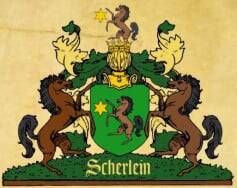Scherlein Family History
Scherlein Family
Coat of Arms

Titles carried by House:
Fürst (Prince), Herzog (duke), Pfalzgraf (count palatine), Graf (Count), Ridder (Knight).
Titled from:
Hungary, Germany, and HRE.
Fürstin Elke Petra Scherlein,
Consort to Prince Carl

Children are:
1st marriage
- Alexandra Scherlein-Haskic, Marco Haskic, Ronny Haskic
2nd marriage
- Christina, Patrick, and Shawn
Fürstin Edeltraud Scherlein-Buhs,
Sister of Princess Elke

Children are:
1st marriage
- Thomas Röhricht
2nd marriage
- Kai Uve Buhs, and Daniela Buhs-Pister
👑House of Scherlein
Family Scherlein / Scheerle / Scheerlin / Schörlin / Schoerlin / Schorlin / Schörling:
Scherlein:
Current head of the family is:
Fürstin Edeltraud Scherlein-Buhs
Consort - deceased
Predecessor:
Father: Fürst Alfred Scherlein
Mother: Fürstin Eva Anna Elsibet Kehler
Last name meaning:
The last name Scherlein is most commonly found in Germany today. It is a German surname that is believed to originate in the region of Westphalia. Records from the region of Cologne suggest the surname is most common in the western region of Germany and can be found in smaller numbers in other areas of the country. It is also found in other countries such as the United States, Austria, Poland, and Czech Republic. According to public records, 2,817 people living in the United States have the last name Scherlein, making it the 44th most common German surname in the U.S.
In Germany, the most common first name associated with the surname Scherlein is Wilhelm (or William). It’s likely the surname came from a given name used for many generations. The combination of "Scher" and the diminutive "lein" is thought to have been added to the surname and used to differentiate between two individuals with the same name. It eventually became a fixed part of the family name. In Westphalia, the name is still commonly associated with the region; both given and surnames. In some cases, Scandanavian immigrants to the region have adopted the surname as well.
In Austria and Poland, the name appears to have a consistent spelling, while other countries have various versions depending on their language and culture. Overall, it appears that the surname is still used in various parts of the world today, primarily in Germany and the United States. It continues to be associated with the region of Westphalia, likely due to its long history in the area. The last name Scherlein has its origins in Germany, where it is believed to derive from the Middle High German word "scher," meaning "to cut" or "to shear," possibly indicating a connection to occupations related to tailoring or shearing sheep.
The name may have first appeared in regions of southern Germany, where such trades were prevalent. Historically, surnames like Scherlein often reflected the profession or characteristics of the individuals who bore them, suggesting that early bearers may have been involved in textile work or agriculture. Variations of the surname can be found in different cultures, including "Scherle" or "Scherlin," which may arise from regional dialects or linguistic adaptations.
While the name is primarily associated with German-speaking areas, it may also appear in other countries due to migration and diaspora, though it remains relatively uncommon outside its region of origin.
Overall, Scherlein encapsulates a rich historical context tied to craftsmanship and trade in medieval Europe. The family arose from knighthood to the High Nobility in Germany achieving the status of Pfalzgraf (count palatine), and Herzog (duke) nobility included the Holy Roman Empire not just German.
The last name Scherlein is found most in Hungary. It may occur as a variant:. Click here for further possible spellings of Scherlein. How Common Is The Last Name Scherlein? The surname Scherlein is the 3,485,539th most frequently used surname on a worldwide basis, held by around 1 in 227,735,810 people. Scherlein occurs mostly in Europe, where 75 percent of Scherlein reside; 63 percent reside in Eastern Europe and 63 percent reside in Hungaro-Europe.
The surname Scherlein is most frequent in Hungary, where it is borne by 20 people, or 1 in 490,814. In Hungary Scherlein is most prevalent in: Komárom-Esztergom County, where 95 percent are found and Veszprém County, where 5 percent are found. Besides Hungary it occurs in 3 countries. It also occurs in The United States, where 22 percent are found and Germany, where 13 percent are found.
Scherlein Family Population Trend historical fluctuation:
The occurrence of Scherlein has changed over time. In The United States the number of people who held the Scherlein surname fell 42 percent between 1880 and 2014. The family has marital ties to the House of Esterházy and a very connected status to the Holy Roman Empire whereas the German Scherlein family has held the titles of Pfalzgraf (count palatine), and Herzog (duke) since 1514.
The House of Esterházy, also spelled Eszterházy (Hungarian pronunciation: [ˈɛstɛrhaːzi]), is a Hungarian noble family with origins in the Middle Ages.[1][2][3][4] From the 17th century, the Esterházys were the greatest landowner magnates of the Kingdom of Hungary, during the time that it was part of the Habsburg monarchy and later Austria-Hungary.
During the history of the Habsburg Empire, the Esterházy family and Scherlein family was consistently loyal to the Habsburg rulers. The Esterhazy's and Hungarian Scherlein families received the title of Graf (Count) in 1626, and the Forchtenstein line of Scherlein received the title of Fürst (Prince) from the Holy Roman Emperor in 1712. The Scherlein family has a strong tie to the Baden-Württemberg area Germany.

